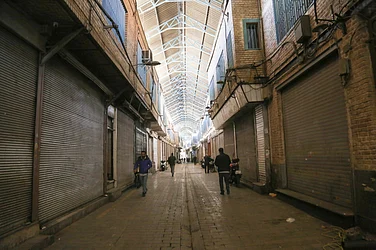A few years ago in London, without a local phone and late for a rendezvous with a friend, I attempted to call him from a public phone booth. My coins were being swallowed up but the call would not connect. I asked passersby if I could borrow their phone, but they walked away. When I did meet my friend with tears of relief, he told me that I needed to add zero as a prefix! It made me wonder that if someone as immensely privileged as I had felt utterly helpless and somewhat small—even where the language was my own—what would be the endless tales of those who attempt to weave themselves into the fabric of a society where their existence might invoke wrath?
“Speak our language!” is thrown at refugees no matter where they attempt to settle in. Gordon Ogutu, a Kenyan researcher based in Ireland, has seen how language, as the necessity to survive, connect and integrate into a new society, is also used to commit violence. Its absence, like the Tower of Babel, also leads to violence. While working in Kakuma refugee camp in northwest Kenya—operational since three decades and home to 300,000 people from 19 nationalities—he saw how English was more vital for the refugees than Kiswahili, if they were to explore economic opportunities. But conflicts were a result of people allocated spaces with someone they do not share the language or culture with.
For instance, fights would erupt at watering points, between a South Sudanese speaking Arabic and Nubian, and a Congolese speaking French and Lingala. When Ogutu sat together with them during an English language and soft-skills development programme, they realised that their quarrel was entirely pointless. “Some cultures communicate loudly, others communicate in lower tones, and this had led to a fight.
Tiny moments of miscommunication because of the linguistic and cultural divide revealed how policies do not account for people’s different backgrounds. There could be better ways of ensuring that people with similar backgrounds are sent to groups within the camps where they would be welcomed linguistically,” Ogutu said.
On the other hand, Kim Khaira has found that the English proficiency of refugees resettling in the US would often deteriorate. This is because of the environment they are exposed to, she said over a long-distance call. “People talk to them in condescending and patronising tones. There are assumptions made about their level of English based on their skin tone and what they wear.” A native of Penang in Malaysia, Khaira has worked as a community and case worker in Penang, and now in Milwaukee in the American midwest, where she
facilitates art projects with refugee and local communities under the aegis of the Lynden Sculpture Garden. Like Ogutu, who has long felt the need for creating opportunities for more intercultural interactions between refugees and local host communities, Khaira too is of the view that policies need to be more conscious of cultural nuances if refugee resettlement has to be a success.
Refugee resettlement, or what is also known as third-country resettlement, gives refugees the right to reside long-term or permanently in that country; even citizenship. Despite an estimated 1.44 million refugees in urgent need of resettlement globally, only 22,770 were resettled through UNHCR in 2020. Refugee resettlement is viewed as one of the most durable solutions for the stability of refugees. However, among the myriad challenges, language and integration are perhaps major challenges—but also opportunities.
In 2016, the Dublin City University (DCU) in Ireland was deemed a University of Sanctuary, thus making a pledge towards welcoming—through scholarships—refugees and those broadly known as international protection applicants (IPAs). With no employment rights, IPAs are given a weekly allowance of EUR 28; higher education thus takes a backseat. Even though the Irish government had drafted a migration integration strategy, the Direct Provision system—accommodation centres that are run for-profit, often in former hotels—means that integration with the local community is not possible.
Dr Julie Daniel had begun her PhD with the assumption that integration is possible only through linguistic and cultural competency. She started the Migrant English Language, Literacy and Intercultural Education (MELLIE) programme, which was aimed at bringing IPAs to DCU and pairing them up with the university community, towards improving their English language skills. “I did not want the project to just help people in need; nor did I want people at DCU to be the White saviour. We wanted a collaboration, whereby the voice of the person new to Ireland was valued. We did not want them to be viewed only for their vulnerability, because nobody should be defined just on that basis,” she told me.
When she piloted the project in 2017 for five weeks—by renting a bus to bring together IPAs to DCU from a Direct Provision centre located deep into the countryside north of Dublin—she had hoped that she would go beyond the formal structures of language pedagogy that do not take into account people’s lived experiences. She developed a format of conversation which would indicate the language learner’s competency. “But it was a disaster! The university community that I had trained to assess language competency were uncomfortable with this format that imparted a sense of hierarchy, while the language learners thought they needed to get the best grades. They later revealed that language was the last thing they wanted to learn formally! We view integration based on our own set of values; whereas for them, building a social network was more urgent in the quest towards integration,” she reminisced.
Dr Daniel then adapted the programme to be only conversational, whereby pairs would talk about food, festivals, familiar landmarks, etc., as conversation starters. Having recently concluded its sixth iteration—each spanning the length of an academic semester—the project turned into a visual storytelling exhibit after she found that pairs were instinctively pulling up photos on their phones to illustrate a bit more about their respective cultures. “The project is now more about building a relationship. So far, 250 people have collaborated, comprising IPAs and the DCU community.”
Ogutu has participated in the MELLIE project twice and was paired up with a 20-something Afghan man, and a Pakistani man in his early 50s. At the end of the project both times, he recognised that not only had their English proficiency improved, but that they were also more confident in initiating a conversation and expressing their views.
And then there was the idea of newfound freedom. “One of them felt a greater sense of freedom in sharing their political views, without having to worry if I was an agent of the state. There were topics they could talk about openly which are taboo in their religious country, and this was liberating for them,” says Ogutu.
Even though Ogutu acknowledges the dire need for more localised initiatives—as has been the clarion call among policymakers globally–-he feels that the educational institution is viewed as a safe space for refugees, thus possibly enabling their healing. Additionally, interacting with the university’s diverse community allows them to see Ireland as a diverse place. “I am a Black man from Kenya pursuing my research here; that could be validating for them. Moreover, students at the university could be agents of change by taking home stories of this diverse group of people who happen to be refugees, and perhaps indirectly alleviate discrimination. Integration is, after all, a two-way street,” Ogutu said.
Khaira has seen that two-way integration first-hand, both in Penang and Milwaukee. Because of the relative cultural and linguistic proximity between Rohingya and Malay, she has seen Rohingya people wear traditional Malay clothes during Eid, in Milwaukee. A mosque opened by the Rohingya community in Milwaukee welcomes everyone. “But being a Muslim in Malaysia does not necessarily unite them all; Rohingya people have faced harassment in mosques in Penang,” she said.
Khaira also feels that there is a significant need for language interpreters who understand cultural nuances, especially for legal and medical assistance. However, when it comes to starting a business, a Rohingya refugee is more likely to be able to successfully get started in Malaysia than in the US. Khaira explains: “In Penang, a refugee could find someone to help them open a business account on proxy. But the US is based on written rules and regulations, which can be intimidating. There are many tests to be taken to get a licence, and studying for them means being able to read and write.”
Ogutu now sees clearly the gaps in Ireland’s refugee policy, with the inadequate preparation to accommodate everyone, which became glaringly evident when Ukrainian refugees began to arrive. While he is happy that he got to share about Kenyan culture with the Afghan and Pakistani men, he feels that they have had a freer experience within the premise of an educational institution than himself: “There are so many things I cannot talk about openly about the institution or about my challenges living in Ireland.” Even so, he feels that it would bode well towards fostering integration and countering far-right discourses if MELLIE were to be replicated on a more local level.
Until 1990, foreign-born residents made up only 2 per cent of Ireland’s population, with immigration largely led by labour demands. Even though the number of foreign-born residents has significantly increased since then, there is much racism faced by the non-White Irish. This can be traced to the creation of a religious-ethnic concept of Irish identity where Irishness equated with being White and Catholic.
The EU deems housing, health, employment opportunities, and education as markers of integration, along with language. “A Chinese family that runs a restaurant in a different country would develop their social capital first but would ensure that their children would learn the local language. So who are we to say that the family has not integrated into society?” Daniel challenges. Even though the French national has been living in Ireland for 16 years, she still struggles with the elastic concept of time in Ireland and the lack of commitment. She knows better now that when an Irish person comments about an idea with “Sure it’s grand”, it essentially means “no”.
Concluding my interview with Ogutu, I thank him for sparing me the academic mumbo-jumbo about policies. He corrects me promptly: “mumbo-jumbo” is Kiswahili, which is an informal way of saying “What’s up!” Or as they say in Ireland, “What’s the craic!”
Priyanka Borpujari is an independent journalist currently based in Ireland. She has previously reported from Japan, Indonesia, Bosnia-Herzegovina, Argentina, El Salvador, and India. She writes a monthly column in the German weekly Die Tageszeitung.
(This appeared in the print as 'The Language Barricade')






















